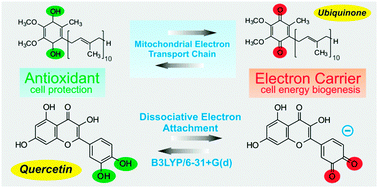Gas-phase dissociative electron attachment to flavonoids and possible similarities to their metabolic pathways
Abstract
The gas-phase empty-level structures and formation of anion states via resonance attachment of low-energy electrons to the

* Corresponding authors
a Università di Bologna, Dipartimento di Chimica “G. Ciamician”, via, Selmi 2, 40126 Bologna, Italy
b
Centro Interdipartimentale di Ricerca in Scienze Ambientali, via, S. Alberto 163, 48123 Ravenna, Italy
E-mail:
alberto.modelli@unibo.it
c
Institute of Molecule and Crystal Physics, Ufa Research Centre, Russian Academy of Sciences, Prospeκt Oktyabrya 151, 450075 Ufa, Russia
E-mail:
sapsh@anrb.ru
The gas-phase empty-level structures and formation of anion states via resonance attachment of low-energy electrons to the

 Please wait while we load your content...
Something went wrong. Try again?
Please wait while we load your content...
Something went wrong. Try again?
A. Modelli and S. A. Pshenichnyuk, Phys. Chem. Chem. Phys., 2013, 15, 1588 DOI: 10.1039/C2CP43379F
To request permission to reproduce material from this article, please go to the Copyright Clearance Center request page.
If you are an author contributing to an RSC publication, you do not need to request permission provided correct acknowledgement is given.
If you are the author of this article, you do not need to request permission to reproduce figures and diagrams provided correct acknowledgement is given. If you want to reproduce the whole article in a third-party publication (excluding your thesis/dissertation for which permission is not required) please go to the Copyright Clearance Center request page.
Read more about how to correctly acknowledge RSC content.
 Fetching data from CrossRef.
Fetching data from CrossRef.
This may take some time to load.
Loading related content
